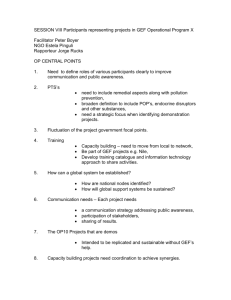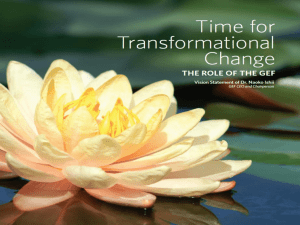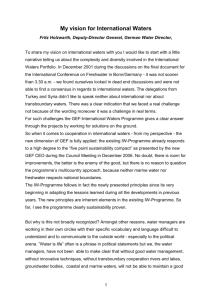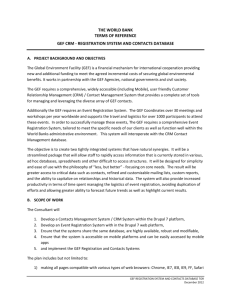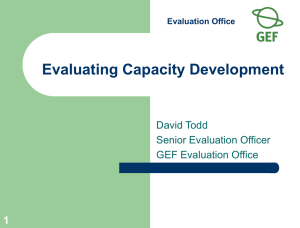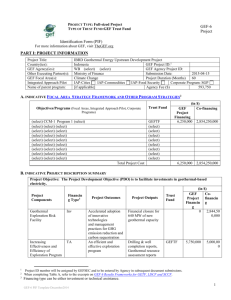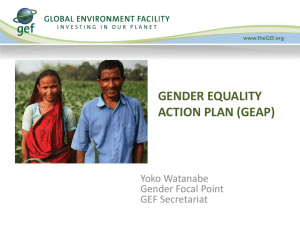Blending Integrated Thinking with Focal Area Objectives
advertisement
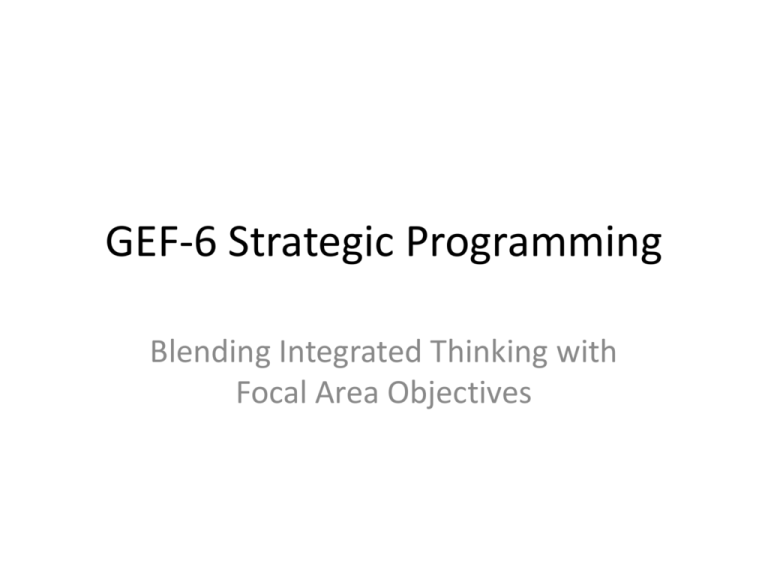
GEF-6 Strategic Programming Blending Integrated Thinking with Focal Area Objectives How GEF Works: What’s New for GEF-6 Guidance Science & Technology Advisory Panel GEF Council Countries: Council Members / Constituencies Evaluation Office Action Operations GEF Implement ing Agencies GEF Secretariat • • • • • • • • • • • • • • UNDP UNEP WB ADB AfDB EBRD FAO IaDB IFAD UNIDO WWF CI IUCN DBSA Executing Agencies Government Agencies Convention Secretariats NGOs / CSOs Private Sector Focal Areas International Waters Biodiversity Chemicals and Waste Climate Change Land Degradation SFM Integrated Pilot Approaches Sustainable Cities Food Security Commodities Integrated Thinking • Drivers of environmental degradation are linked in complex ways • Single issue analysis leads to “silo” thinking • Systems analysis leads to integrated thinking • Integrated thinking inspires creative and inclusive solutions • Creative and inclusive solutions deliver environmental benefits aligned with GEF focal area objectives Examples of Integrated Thinking • Water, Food, Energy Nexus Cost of Power & Fuel Availability of Food Biodiversity impacts Cost of Water Food prices Human Health Natural Disasters Water, Food, Energy Nexus Availability, distribution, access and sustainability of water, food, energy and their resilience in the face of climate change. 9. Managing the Humaninterface: landscape/seascape approach 4.Water/Food/Energy/ Ecosystem Security Nexus SFM 1: To maintain forest resources LD 3: Integrated Landscapes Objective 1: Promote innovation & technology transfer Focal Area Objectives • The solutions should deliver results that align with GEF-6 focal area objectives GEF IW investment modality Delivering GEF International Waters Global Environment Benefits Transformational Change Full-scale SAP Implementation Strengthening policy and legal and institutional frameworks Foundational Capacity Building/Enabling environments, Basic Policy and cooperation framework GEF-6 IW Strategy Goal: To promote collective management of transboundary water systems and implementation of the full range of policy, legal and institutional reforms and investments contributing to sustainable use and maintenance of ecosystem services Objective 1: Catalyze Sustainable Management of Transboundary Waters Objective 2: Balance Competing Water-uses in the Management of Transboundary Surface and Groundwater 1. Foster Cooperation for Sustainable use of Transboundary Water Systems & Economic Growth 3. Advance Conjunctive Management of Surface & Groundwater systems Objective 3: Rebuild Marine Fisheries, Restore and Protect Coastal Habitats, and Reduce Pollution of Coasts and LMEs 5. Reduce Ocean Hypoxia 6. Prevent the Loss and Degradation of Coastal Habitat 2 .Increase Resilience & Flow of Ecosystems Services in Context of Melting High Altitude Glaciers 4. Water/Food/Energy/ Ecosystem Security Nexus 7. Foster Sustainable Fisheries • IW Program 4, Nexus In order to address transboundary pollution from industrial, agricultural and municipal sources, including by heavy metals from mining, tanning and/or dying industries, organic pollutants, sediments, as well as introduction of invasive species, regionally agreed regulatory approaches, incentive mechanisms, and innovative technologies involving both public and private sector actors are needed. Therefore, GEF is promoting integrated ‘ridge-to reef’ approaches, including proactive strategies and innovative investments directed at pollution reduction from different sectors to address hypoxia in lakes and coastal areas. Active stakeholders in these investments include policy makers and civil society, including private sector players such as capital providers, large corporations, SMEs, local business councils and other groups of small scale individual entrepreneurs. • IW Program 5, Reducing Ocean Hypoxia: Innovative policy, economic, and financial tools, public-private partnerships and demonstrations will be pursued with relevant governments and sectors towards ‘closing the loop’ on nutrient production and utilization and restoring nutrient balance within planetary boundaries and eliminating or substantially decreasing the extent of dead zones. Recognizing the IW portfolio gaps identified in the GEF STAP Hypoxia report GEF will initiate collaboration through targeted research as well as with the private sector, including capital providers, large corporations, SMEs, and groups of small scale individual entrepreneurs. Actions under GEF-6 will be closely tied to, and in instances directly combined with, support under the GEF Land Degradation Focal Area. GEF-6 LD Strategy Goal: To arrest or reverse land degradation (desertification and deforestation) LD 1: Agriculture and Rangeland Systems 1. Agro-ecological Intensification – efficient use of natural capital (land, soil, water, and vegetation) in crop and livestock production systems 2. SLM in Climate-Smart Agriculture – innovative practices for increasing vegetative cover and soil organic carbon LD 2: Forest Landscapes 3. Landscape Management and Restoration – community and livelihood-based options for increasing forest and tree cover LD 3: Integrated Landscapes 4. Scaling-up SLM – moving appropriate interventions to scale for crop and rangeland productivity LD 4: Institutional and Policy Frameworks 5. Mainstreaming SLM in Development – influencing institutions, policies, and governance frameworks for SLM GEF-6 C&W Strategy Goal: to prevent the exposure of human and the environment to harmful C&W of global importance, including POPs, mercury and ODS, through a significant reduction in the production, use, consumption and emissions/releases of those chemicals and waste Objective 1: Develop the enabling conditions, tools and environment for the sound management of harmful chemicals and wastes Objective 2: Reduce the prevalence of harmful chemicals and waste and support the implementation of clean alternative technologies/substances 3. Reduction and elimination of POPs 1. Develop and demonstrate new tools and economic approaches for managing harmful chemicals and waste in a sound manner 2. Support enabling activities and promote their integration into national budgets and planning processes, national and sector policies and actions and global monitoring 4. Reduction or elimination of anthropogenic emissions and releases of mercury to the environment 5. Complete the phase out of ODS in CEITs and assist Article 5 countries under the Montreal Protocol to achieve climate mitigation benefits 6. Support regional approaches to eliminate and reduce harmful chemicals and waste in LDCs and SIDs GEF-6 BD Strategy Goal: To maintain globally significant biodiversity and the ecosystem goods and services that it provides to society BD1: Improve Sustainability of Protected Area System 1. Improving financial sustainability and effective management of national ecological infrastructure 2 . Expanding the reach of the global protected area estate. BD 2: Reduce threats to Globally Significant Biodiversity BD 3: Sustainable Use of Biodiversity 3. Preventing extinction of known threatened species 6. Ridge to Reef: Maintaining integrity and function of globally significant coral reefs 9. Managing the Human- interface: landscape/seascape approach 4. Prevention, control, and mgmt of Invasive Alien Species. 7. Securing Agriculture’s Future: Sustainable use of plants and animals genetic resources. 10. Integration of biodiversity and ecosystem services in development and financial planning 5. Implementing the Cartagena Protocol of Biosafety 8. Implementing the Nagoya Protocol on Access and Benefit Sharing. BD4: Mainstreaming Biodiversity Conservation and Sustainable Use in Production Landscapes/ Seascapes and Sectors International Waters marine project grants from 1992-2014 ($1.15 Billion) 9% Global Partnership of Action (nutrient or land-based pollution reduction) (Co-financing ratio 1:11) 2% Large Marine Ecosystems (Co-finance ratio 1:4) 7% 37% Coastal and Ocean fisheries (Co-finance ratio 1:6) 6% Integrated Coastal Management (Co-finance ratio 1:5) Knowledge Management (Co-finance ratio 1:3) 14% Persistent Toxic Substances (Co-finance ratio 1:1) 25% Shipping (Co-finance ratio 1:1) Examples of existing portfolio WB/GEF Investment Fund for Pollution Reduction in the LMEs of East Asia • Tranche 1: US$35 million Tranche 2: US$30 million Tranche 3: US$15 million • Total: US$80 million • The first phase of the Investment Fund was approved by the GEF Council in two tranches: in November 2005 (Tranche 1a; US$25 million) and in November 2007 (Tranche 1b; US$10 million). • The IF is to co-finance projects in support of infrastructure, technical assistance, capacity building, and information dissemination and replication. All projects would be associated with other sources of funding, in particular World Bank operations (providing significant co-finance). • Expected outcomes of the Fund would be increased investment in activities that reduce land-based pollution and the replication of cost-effective pollution reduction technologies and techniques demonstrated by the Fund. GEF 5 related projects (with possible synergies/ opportunities) • UNEP (UNDP)/GEF - Integrating Water, Land and Ecosystem Management in Caribbean Small Island Developing States (IWEco) • UNIDO/GEF - Gulf of Mexico • UNEP/GEF- African Small Island Development States UNEP/GEF Blue Forest WB/GEF Capturing Coral Reef and Related Ecosystem Services (CCRES) WB cross support exercise - Thinking out of the box Blue Biomass Marine nutrients: an unutilized resource …The Danish example Macro algae cultivation and utilization as a new instrument within the Danish water schemes Reality High level of conflict between farmers and policy objectives on Water Framework Directive targets. - 9,000 (19,000) tons N per year reduction targets. Reality • Production of animal protein and grains is highly effective, but… o An annual 1400 ton/P and approx. 60.000 ton/N is still lost to marine ecosystems. • Effect on environment: eutrophication, causing habitat loss and expansion of coastal dead zones. • Political reaction: Three decades of heavy regulation of agricultural/aquacultural industries have lead to high level of conflict (nature vs. competitiveness). • Prevailing Danish environmental approach: Nutrients considered a source of pollution, not an unutilized productive resource. Green growth solutions needed: combining economically and environmentally intelligent solutions… New opportunities? Sugar kelp as a cost effective bio-filter capable of mitigating eutrophication and creating green growth synergies? A good yield depends on selection of right cultivation areas • Temperature • Light • Depth and sedimentation • Current • Salinity • Nutrient flows Upwelling within Danish inner waters Indicative yield data Average wheat yield per hectare in DK = 8 tons per year. A two year sugar kelp production cycle produces an average of 5.26 tons (dry weight) per year, corresponding to 66 % of the yearly wheat yield. Placing of Growing rope periods in seedlines months Harvest Yield pr m time rope in kg wet weight Yield pr long Yield pr hectare in line in ton tons wet (W) and wet weight dry (D) weight Sep - Nov August 14.62 22 - 24 17.55 Indicative data from Seaweed Seed Supplys Danish based production 58.48 (29.24) W 10.53 (5.26) D Conversion of political nitrogen reduction targets to biomass Nitrogen reduction target Production Production in wet in dry weight weight Phosphorus loss from agriculture Biomass phosphorus fixation Difference: phosphorus loss/capture Required area (ha) 19,000 4,269,663 768,539 1,400 3,846 -2,446 146,021 9,000 2,022,472 364,045 1,400 1,822 -422 69,168 1,000 224,719 40,449 1,400 202 1,198 7,685 Dry matter nitrogen content: 2.47 % (+/- 0.13) - Gevaert et al (2001). Dry matter phosphorus content: 0.5 % - Murata et al (2001). August harvest: 130 kilo N per hectare per year. In reality commercial interests, nature conservation and recreational interests must be balanced Production costs Business case today (Danish production costs): Production costs (including overheads and R & D): 77€ ton/wet weight Breakdown: o 22,47 € hatchery o 35,49 € growout Revenue: • Produce sold to pig feed producer: 100 €/ton wet weight. • Additional revenue of approw. 40€/ton wet weight achieved throug N-kvotas to fish producers. The future? Concepts suited for implementation in high seas areas are under development and expected to reduce production costs to below 30 €/ton. Global aquaculture production of fish for consumption has 12-dobled over last three decades (1980-2010) The state of World Fisheries, FAO, 2012. May 2003: 640 USD per MT May 2013: 1835 USD per MT Peru Fish meal/pellets 65% protein, CIF, US Dollars per Metric Ton http://www.indexmundi.com Key trial results Use of non fermented Sugar Kelp meal in fish pellets (5-10 % blend) as a substitute for fishmeal: The kelp seaweed protein level is lower (approx. 10-15 %) than the standard protein requirement for fish, however: • • The seaweed inclusion doesn´t compromise with growth performance, while feed intake is similar to standard feed. Reason: most likely due to better digestion of the overall protein material. Effect: o Increased digestiability leads to a reduction in overall protein content by 14% compared to conventional feed. o When calculating both fish intake/deposition of protein the overall nutrient loss is reduced by 24% compared to conventional fish feed. o Further, feed containing seaweed is proved to reduce salmon fish lice outbreaks and the improve coloring of fish meat when slaughtered. Timeline: within 12 onts a fully developed fish feed is expected to be introduced to market. Danish fulfilment of EU reneable energy directive Data should be verified as the different assumptions are tested on a commercial basis. Sugar kelp biomass yield 29.2 tons (wet weight) per ha per year 5.3 tons (dry weight) per ha per year Bioethanol yield (laboratory scale) 80 % conversion of carbohydrates: 0.281 l bio-ethanol per k dry weight (Wargacki et al, 2012) 1,489 l bioethanol per ha per year EU reneable energy directive fulfillment (25 million l): biomass and areal requirements Biomass (dry weight): 90,000 per year Areal requirements: 17,000 ha per year Nutrient and CO2 fixation Nitrogen: 2,200 ton/year Phosphorus: 450 ton/year CO2: 162,000 ton/year (Bruhn et al, 2010) Asian seaweed production Future perception of green growth • Mutual dependencies between healthy land and sea based production systems increases the overall value within both systems and thereby industry incentives to preserve them… So, is it really that simple? • • • • • • • • LARGE AREA AVAILABLE NO NEED FOR FRESH WATER HIGHER GROWTH RATE LOW COST BIOMASS WITH MANY APPLICATIONS NO DRAUGHTS, FROST, FLOODS, FIRE NO FOOD VS. FUEL ISSUE NO NEED FOR FERTILIZER NO NEED TO CLEAR AREAS – (No Indirect Land Use Change) • • • • • • • • • MULTIPLE CROP ABILITY MOVABLE FARMS SCALABILITY ECONOMICS OF SCALE LOW COST LOGISTICS LOW CO2 FOOTPRINT NO WATER POLLUTION BIOFILTER- CLEAN UP STRONG DEMAND FOR A SUSTAINABLE BIOMASS https://www.facebook.com/photo.php?v=10201016509194577&set=vb.118 720564900442&type=2&theater GEF IW and aquaculture • Forms only a minor part of the GEF 6 IW strategic objectives • There should be strong country buy-in and International Waters investments should form part of the TDA/SAP approach • Focus on innovation and optimal resource use within multi-tropic systems
